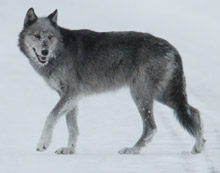There's an interesting study just now surfacing that wolf opponents in the greater Yellowstone ecosystem probably won't warmly embrace.
 Conducted by a Michigan Technological University researcher, it says the decline in Yellowstone's elk population through the past decade can't all be blamed on the park's wolf recovery program.
Conducted by a Michigan Technological University researcher, it says the decline in Yellowstone's elk population through the past decade can't all be blamed on the park's wolf recovery program.
Elk numbers in Yellowstone have dropped pretty sharply since 1995. During that period, the herds' combined population went from about 17,000 animals to roughly 9,500, a 44 percent decrease. And while elk are the favorite food of the park's wolves, John Vucetich says "you don't need wolves in the picture at all the explain the population drop."
Vucetich, an assistant professor at MTU, says the biggest factors behind the decline in elk numbers are drought conditions and hunting pressure.
"Our work shows that the timing of the elk decline is coincidental with wolf reintroduction and that other factors are to blame," he says.
In Yellowstone, Doug Smith, who heads the park's Wolf Project, welcomed Vucetich's study but says more research is needed to clearly identify the reasons behind the population drop.
"Wolf impacts on elk are one of the most controversial aspects of wolf restoration in all the West," Smith says. "This is one of the first definitive analyses about the impacts of wolves on elk and indicates that for the first 10 years, wolves may not have had a dramatic impact on elk numbers -- that elk were declining anyway.
"This viewpoint has been hotly contested," he adds. "Continued debate and research hopefully will create clarity and agreement for the benefit of elk, wolves and humans."
In assessing his data, Vucetich says wolves generally prey on elk that "would have died even if the wolves had not killed them" due to sickness or old age. Hunters, though, are more random in the animals they kill and can more greatly have a negative effect on the herd by taking elk at the peak of their reproductive years.
What kind of reaction will Vucetich's research generate? Over at the University of Idaho's Department of Philosophy, Assistant Professor Michael Nelson expects many Westerners to reject it.
"One of the main motivators behind the effort to remove wolves from the Endangered Species List in the West is the assumption that they are largely responsible for noticeable elk herd reductions," says Nelson. "If that's true, then wolves are therefore linked to decreased hunter success rates, and therefore linked to decreased hunting tourism dollars.
"Vucetich's findings will be viewed as surprising because many people are invested in the claim that wolves are responsible for elk herd reductions. Though they probably won't change their minds given this one study, it certainly does muddy the waters."

 Support Essential Coverage of Essential Places
Support Essential Coverage of Essential Places






